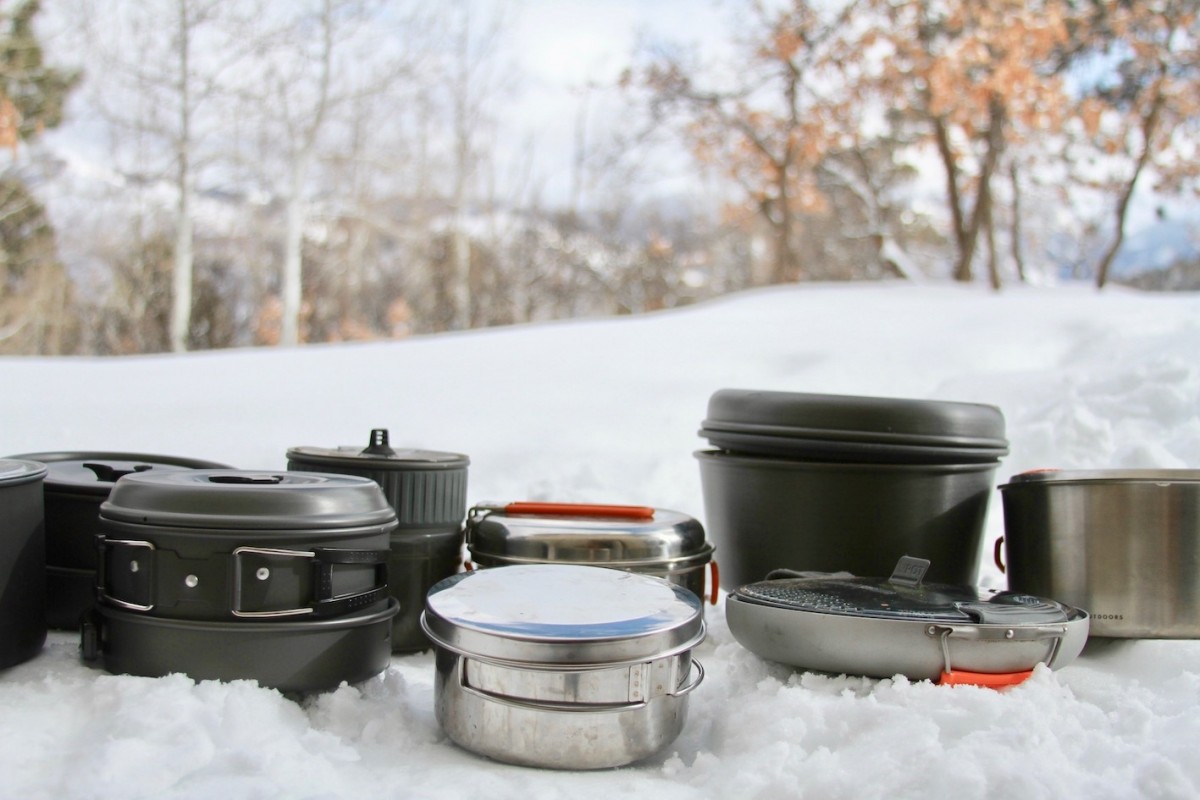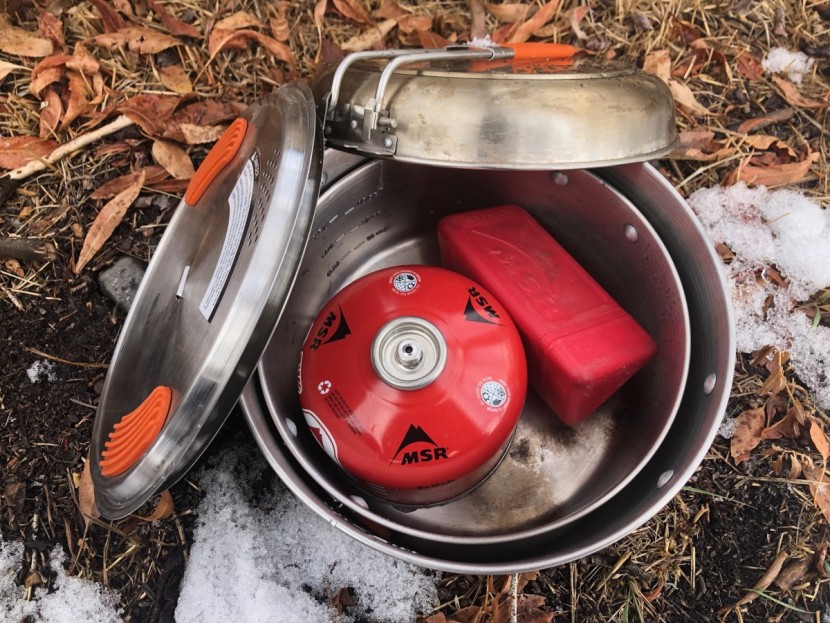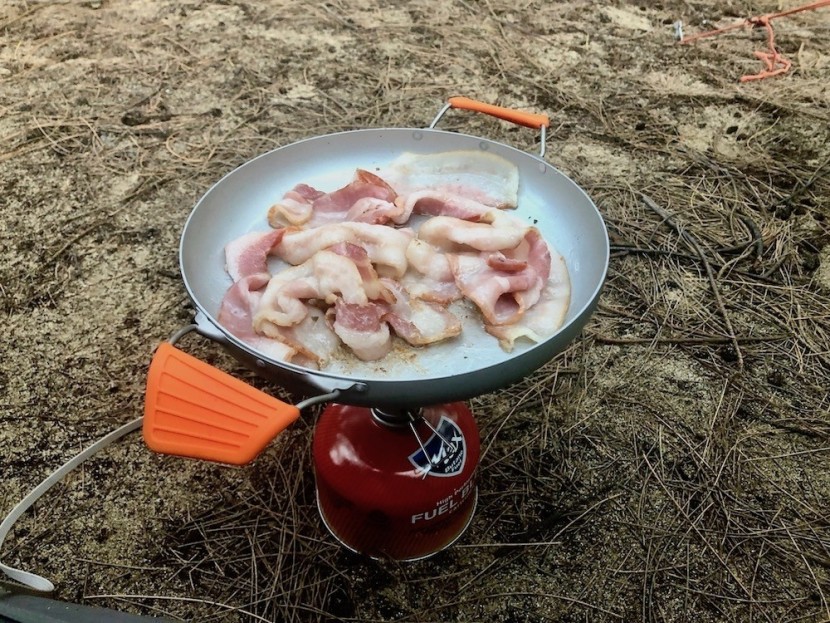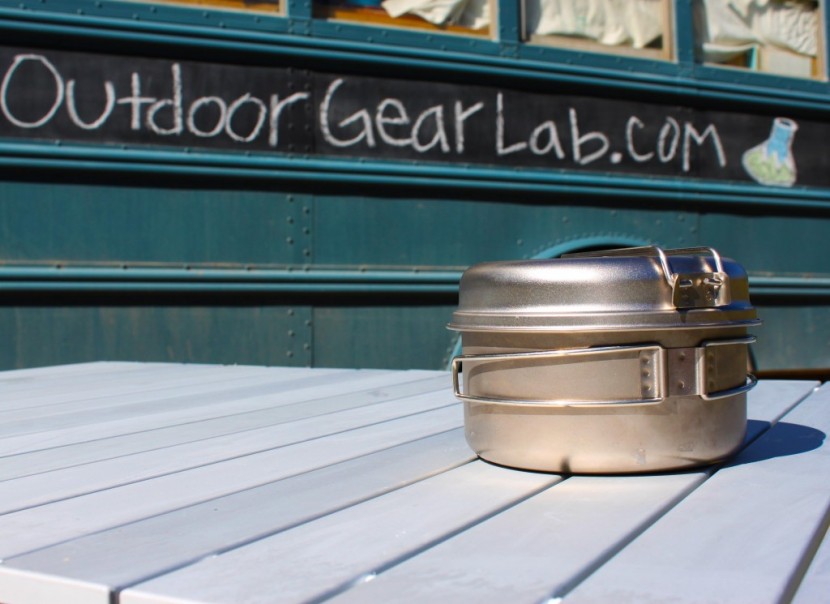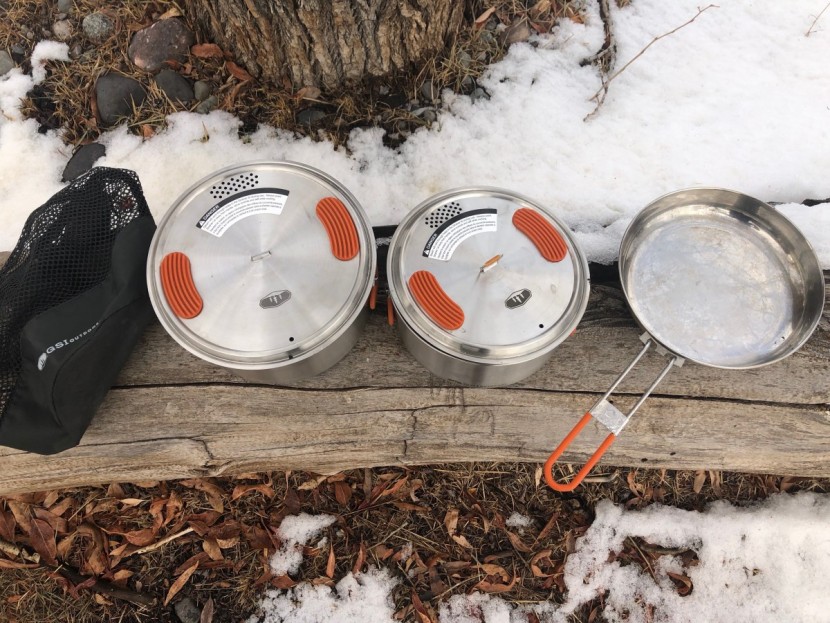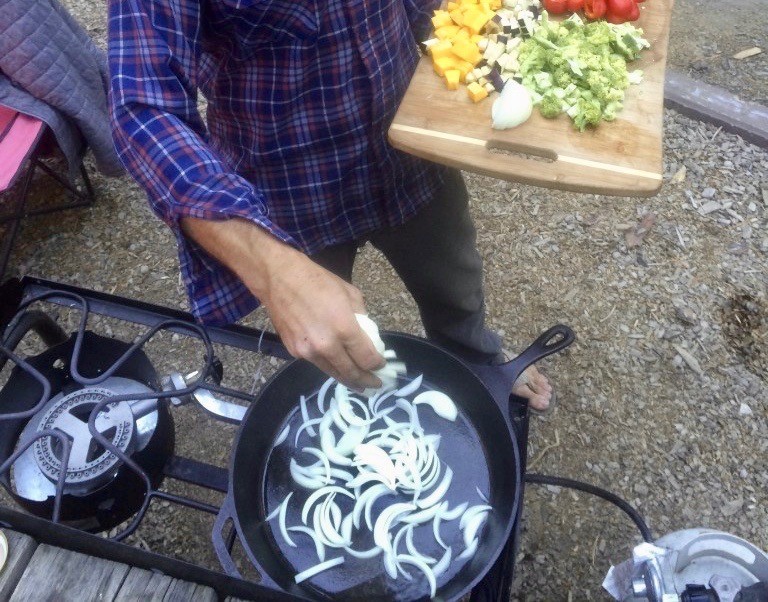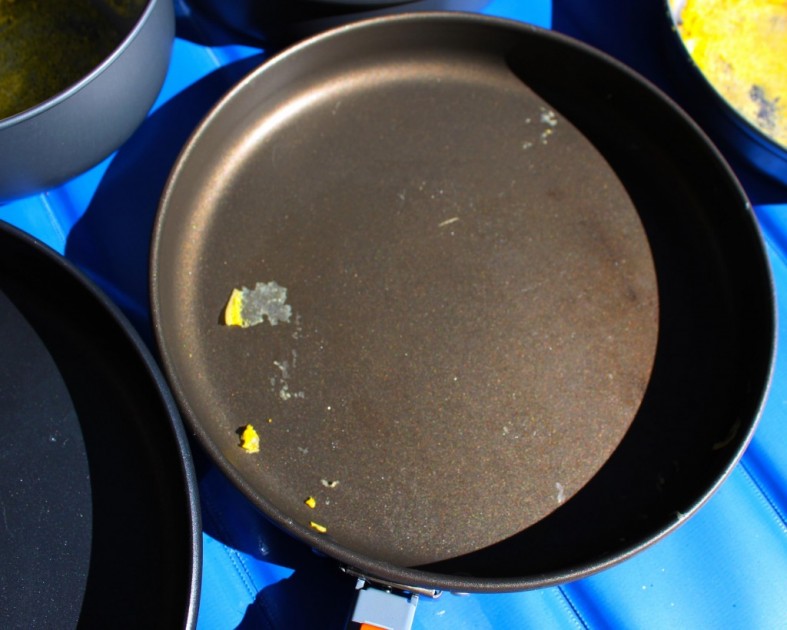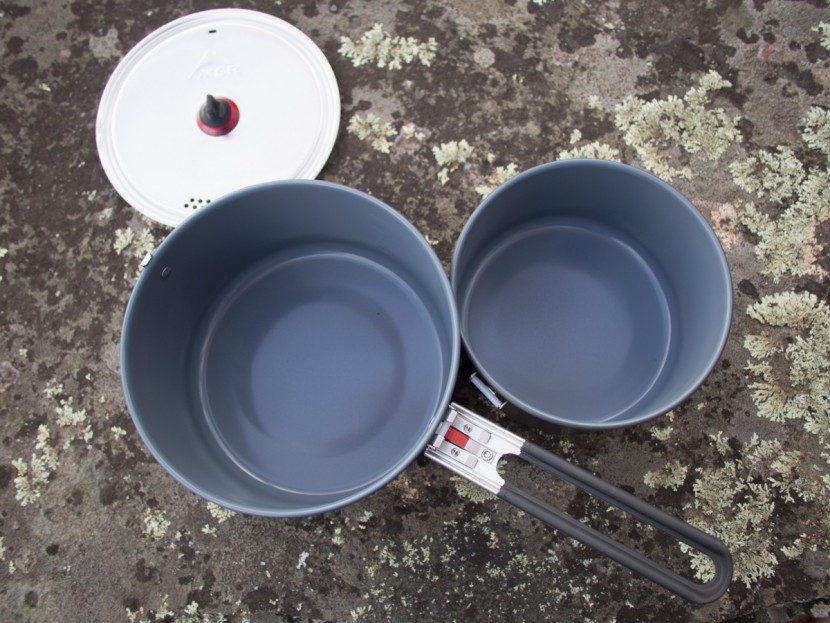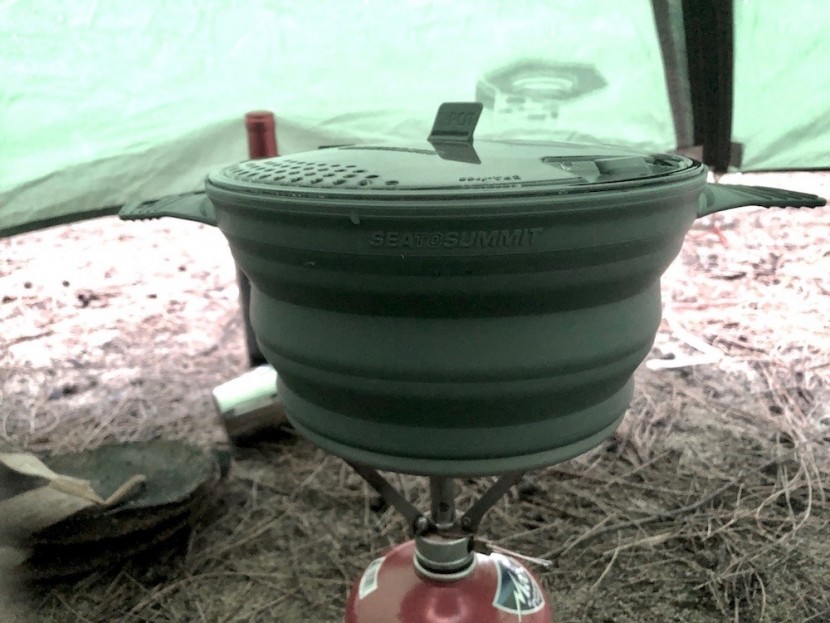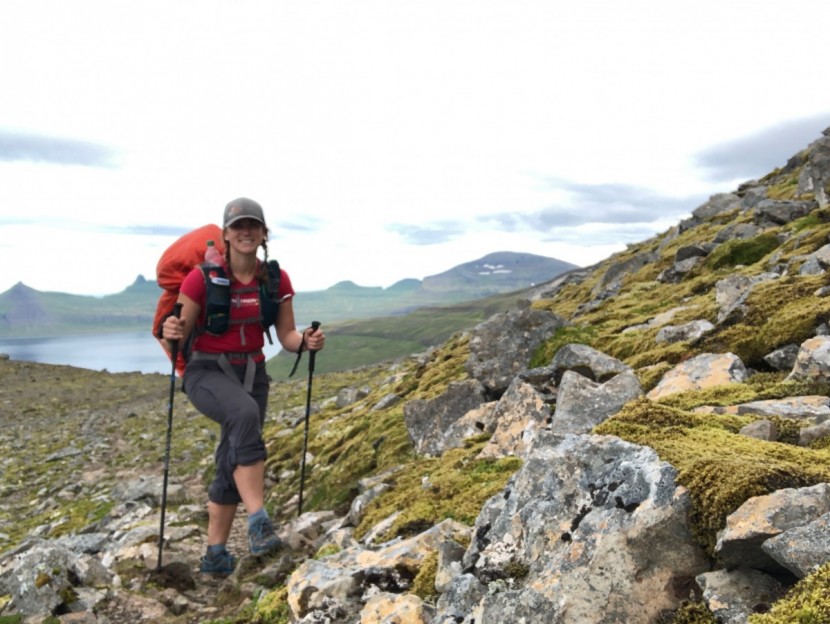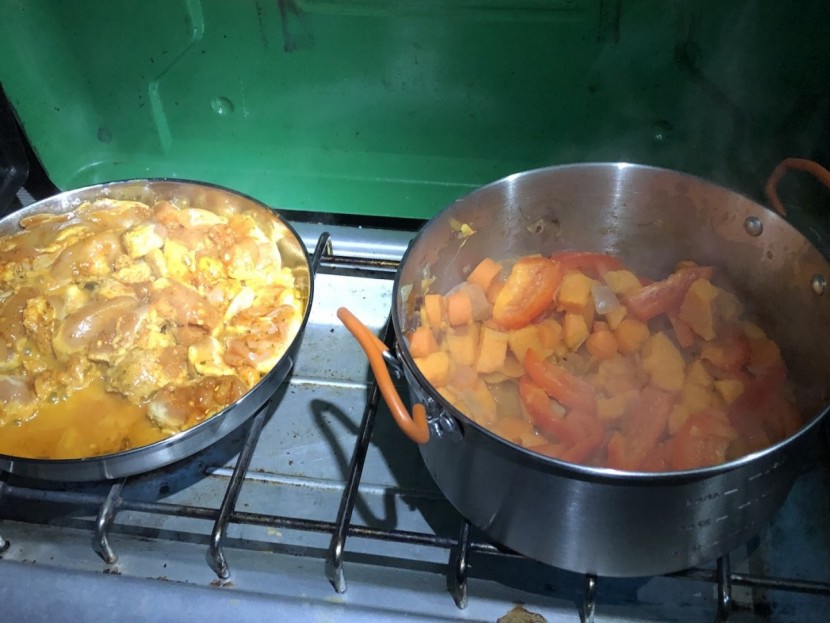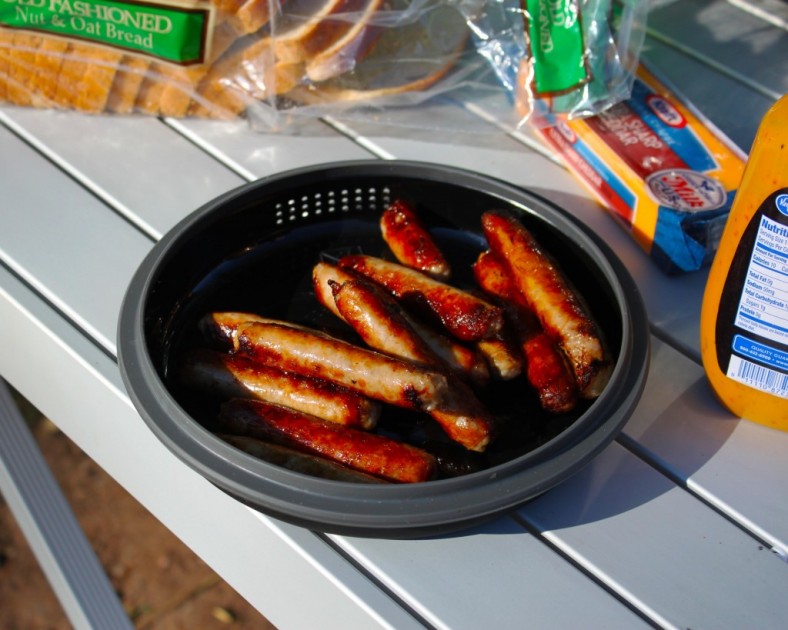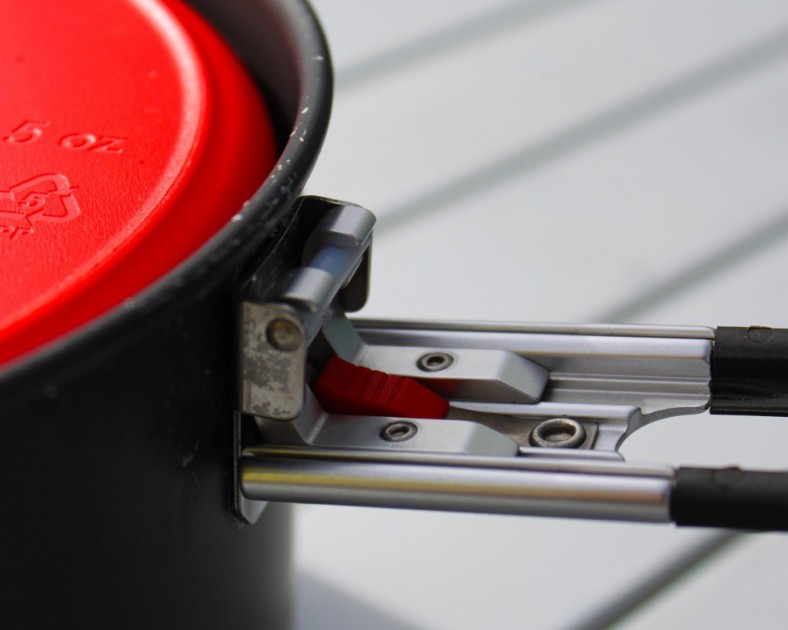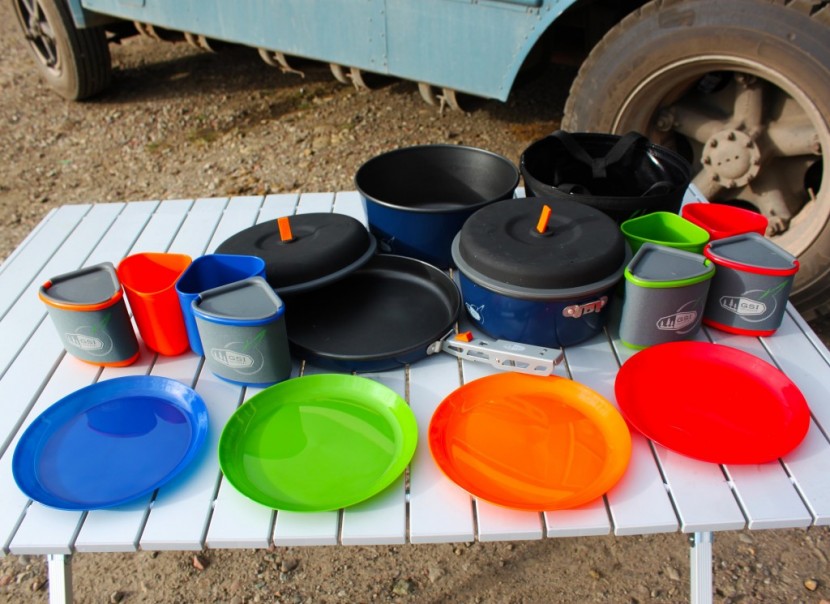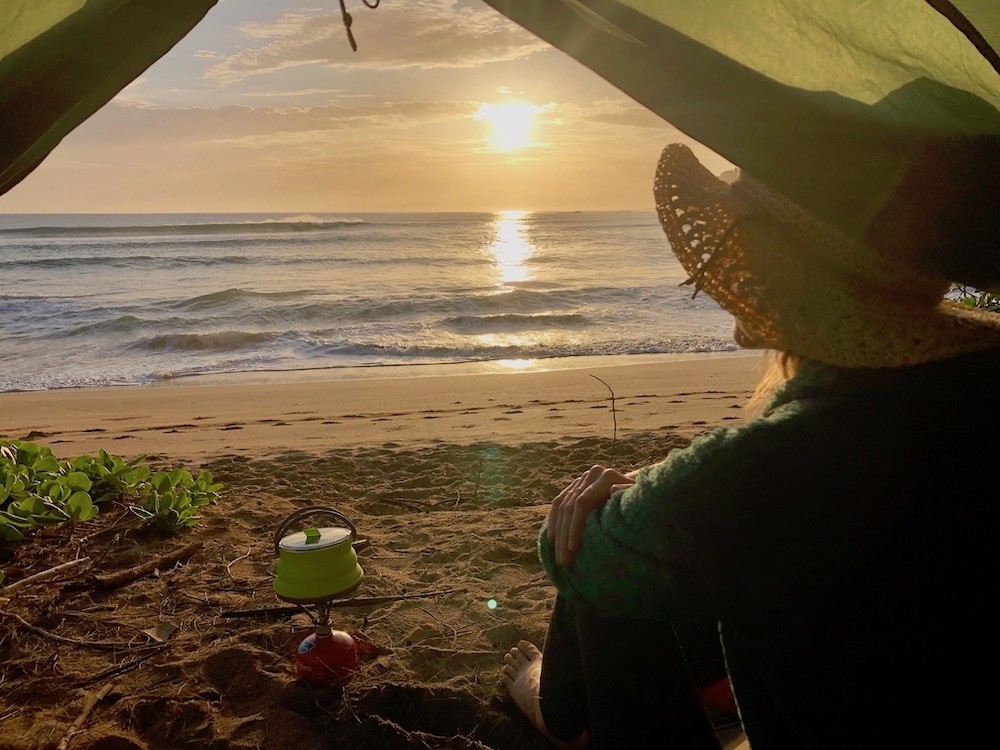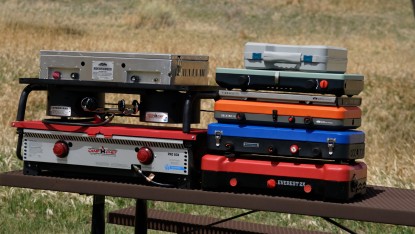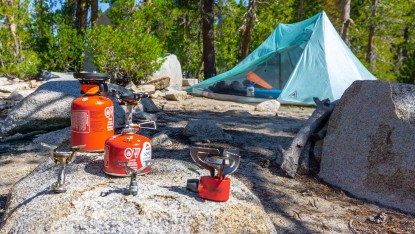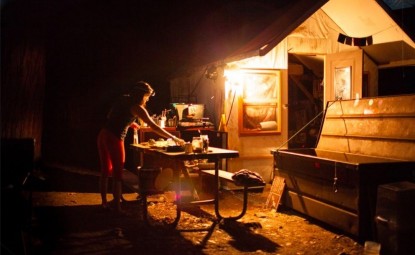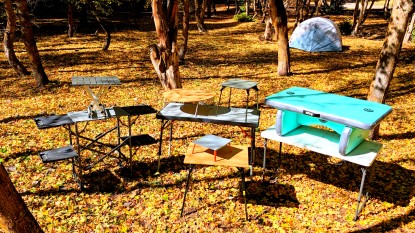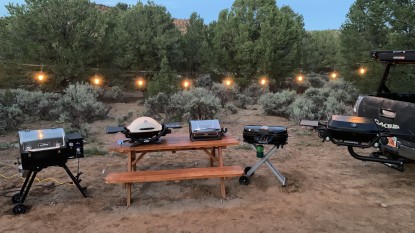We've chopped, sauteed, and cooked up some mean meals with a wide range of camp cookware on the market. So which is the best for you? With so many options glaring at you from the shelves of your local adventure store, it may be hard to decide. When buying a camping cookware set it's important to know about the construction of the set-up and features that you might not even know you're looking for. Take a quick adventure with us to explore everything you need to know about buying a new set of camping cookware.
Consider Your Cooking Setup
As with all gear considerations, we like for you to first take a look at how you will be using it. Are you looking for camping cookware that will accommodate a group of four or more, two people, or just you? Will you primarily be cooking at a campsite with your vehicle nearby or far into the backcountry?
Car Camping vs. Backpacking
Typically speaking, if you are car camping, you're probably looking for an all-around set and won't mind if it happens to be a little on the heavy side. Most likely you're also toting around a portable grill, a two-burner propane camping stove or some sort of variation of the two. Most camping cookware sets have a flat bottom construction, but that is definitely something to pay attention to as it is the ideal setup you'll want while cooking on stoves that are typically used for car camping situations.
Backcountry setups are quite different from what we would take along to a drive-in campsite, whether you're on a thru-hike or high over a valley making gourmet ramen on a portaledge. Weight is a paramount consideration for backpacking cookware, and you may not care less about whether it cooks an egg evenly, as most meals are centered around boiling water. You may not even need a pot or pan, with a kettle sufficing to boil water on the go.
Types of Materials
Camping cookware comes in a variety of materials to meet the needs of everyone, from fast and light to the dedicated backcountry chef looking for tools that mirror their cookware at home. Each material has its key benefits and downfalls, and understanding them will help you pick what fits best for your home-away-from-home camping kitchen.
AluminumPros: Affordable while remaining lightweight, conducts heat well, and can quicken cooking time.
Cons: Raw aluminum can react with acid and alkaline foods, changing their flavor. It also dents and warps easily. However, the sets we tested were all anodized, making them harder and not as reactive to certain foods.
Best Uses: Simmering foods without scorching.
Aluminum conducts heat well and is lightweight. Cookware made from aluminum is typically affordable but less durable than stainless steel and easier to dent or scratch.
Hard-Anodized Aluminum
Pros: “Hard-anodizing” creates a thicker coating than regular anodizing (up to three times thicker). This material is more durable than raw or regular anodized aluminum.
Cons: It's often combined with a non-stick coating and may require more mindful maintenance. More expensive than aluminum.
Best Uses: Cooking real meals with fresh ingredients.
Hard-anodized aluminum is the bee's knees when it comes to an all-around top choice for camping usage. It's also a popular choice for home-based cookware as well. It conducts heat evenly, is lightweight, and easy to clean, especially when coated with a non-stick finish, as many of the sets we tested. It is durable and resists abrasions, but you will have to be more mindful of anything with a non-stick coating. Because it disperses heat more uniformly across the cookware's surface, it is a better choice for cooking meals with fresh ingredients or temperature-sensitive foods like eggs. It is also an efficient heat conductor, which helps to save fuel, allowing fast-packers and solo travelers to further shed weight to move quickly.
Titanium
Pros: Astoundingly lightweight. The thin wall construction allows pots/pans to heat quickly.
Cons: Creates hot spots due to poor heat conductivity. Expensive compared to other available options.
Best Uses: Fast and light users making backcountry meals that mostly involve boiling water.
Titanium's most significant advantage is its ultralight performance. In fact, titanium cookware is about 45% lighter than steel and stronger than aluminum. It is the lightest cookware material you can buy without sacrificing strength. It is also corrosion-resistant and durable. Due to the thin walls used in titanium pot construction, it is ideal for no more than boiling water as it transfers heat quickly and efficiently. However, much like stainless steel pots, they do not disperse heat evenly and tend to develop hot spots directly over the burner with much cooler surfaces elsewhere. Although titanium is ridiculously light, the biggest downside is the expense of the material. Titanium sets are favored by fast and light users, particularly thru-hikers, who are concerned with shedding pounds or even mere ounces wherever possible.
Stainless Steel
Pros: Durable material and scratch-resistant so you can use steel wool during cleaning.
Cons: Uneven cooking that is prone to hot spots, usually heavier than other cookware.
Best Uses: Situations in which you are particularly hard on your gear, ideal for guides.
When it comes to cooking, plain stainless steel camping cookware finds its place somewhere between aluminum and titanium regarding performance and suitability. It does not conduct heat particularly well, which can lead to hot spots and burned food, as well as going through extra propane canisters. However, stainless steel is exceptionally durable, so it is perfect for when your pots take a lot of abuse. This makes it an excellent option for backcountry travelers who are particularly rough on their gear, or in guided scenarios, where cooks prepare a lot of meals on a wide range of adventures.
Unfortunately, stainless steel is also rather heavy, especially when compared to hard-anodized aluminum sets, but it is by far the most robust and most scratch-resistant. While food sticks readily to stainless steel because it is scratch-resistant, you can use a steel wool pad during cleanup. Stainless steel cookware can also be made with multi-layer bottoms. Laminated stainless steel cookware is usually steel outside and inside, with a layer of copper sandwiched between for better conduction and dispersal of heat. Steel cookware like this conducts better even than aluminum, but is much, much heavier. Laminated steel cookware is really only suitable for car camping, and mechanized or animal supported trips.
Cast IronPros: Lasts a lifetime, cooks evenly, naturally non-stick, great for cooking or baking over stove or campfire.
Cons: Heavy, requires periodic re-seasoning to retain non-stick surface, not for backpacking.
Best Uses: Car camping cooking (and everyday cooking at home too!).
We love cast iron for car camping cooking. A cast-iron skillet and/or a dutch oven can be great additions to your cookware arsenal. While we focused on cookware sets in this review, we recommend you augment your cookware with a skillet, which fits nicely on most camping stoves, and yet is big enough for most car-camping cooking needs. We consider a cast iron skillet to be a crucial part of our cooking gear. Why cast iron? It is highly regarded due to even cooking heat, the natural non-stick surface, and durability. A quality cast iron skillet will literally last a lifetime (or two), and you can use it at home as well as when camping.
So, what's the downside to cast iron? Well, cast iron is heavy for one thing; you're not going to take it backpacking. But, it also requires a bit more knowledge on maintenance and keeping your cast iron properly seasoned.
Teflon Type Non-Stick CoatingsPros: Requires less cooking oil while preparing meals and makes for easy cleanup.
Cons: Scratches easily, breaks down quickly once scratched. Dislodged pieces of coating are unhealthy.
Best Uses: Car camping where easy clean up is paramount.
Camping cookware with a non-stick coating is best for simple cleanup, which also means you need less oil for cooking. However, they're more easily scratched than uncoated pots and pans, so avoid using metal utensils with them. Plus, once the cookware is scratched, the coating can come off in large chunks that should not be ingested.
Ceramic Non-Stick Coatings
Pros: Similar non-stick performance and durability to Teflon.
Cons: More expensive and less widely available than Teflon.
We were able to test what is undoubtedly the “latest and greatest” technological improvement to come to camp cookware in a while. People have been using ceramic non-stick cookware in their home kitchens for years, but it hasn't been available as camp cookware. MSR and a couple of other companies have bucked this trend and are offering ceramic camping kitchen gear. The equipment is more expensive but likely healthier and, depending on how you see it, should be considered longer lasting than Teflon.
Head to head, both Teflon and ceramic nonstick coatings degrade at about the same rate, all else equal. However, as Teflon degrades the unhealthy flakes come off into your food. With ceramic, the flakes also enter your food, but they are basically inert. Ceramic cookware appeals to the very health-conscious, and it should also appeal to anyone looking for longer-term performance. Nonstick cookware remains functional long after the coating has begun to degrade. Ceramic cookware stays healthy through this process, while Teflon (to some, debatably…) does not.
Collapsible Silicon SidewallsPros: Super packable and convenient for travel
Cons: Hard to use, potential issues in durability
The new collapsible products that are coming out are pretty neat. They perform well on the stove, offer great packability, at the price of simply needing to be more vigilant on smaller stoves. We really do like these products, though we do need to give you a word of caution. Be sure to follow the directions on the package, and be sure to watch your food on the burner to prevent bent lids and potential holes in the side-walls of your pot.
Choose your pieces
You'll want an assortment of pots, skillets, lids, utensils, plates, bowls, and cups or potentially mugs. Again, your camping kitchen will depend largely on your activities, the stove you're using, and the number of mouths you're feeding. Most manufacturers count a lid as a piece, and it might fit more than one pot or pan in the set. Don't overbuy; a set that contains more pieces might not be the smartest choice if you use only a few and the rest just end up taking up a bunch of space. Also, note that utensils and even a teapot may count as pieces of a set.
While we have compiled comprehensive articles documenting what we feel is the ideal camping kitchen kit, let us also briefly list cooking and eating equipment for two main activities.
For ultralight backpacking you need:- An ultralight one-liter pot for every 1-4 people
- A spoon for every person
- A menu that involves “just add water meals” and at least each person's first meal carried in a foiled, sealable bag that becomes your "bowl"
- The willingness to drink all your beverages from a water bottle
- Literally, that is it. Keep it simple.
For car camping (and for “normal” backpacking, select a subset from this list):
- A “main” 2-3 liter pot for every 1-4 people, with a lid
- A second pot/large bowl
- A frying pan, with lid
- Cutting board
- Knife
- Plate/deep bowl for each person
- Spoon and fork for each person
- Mug/cup for each person
- A clean-up plan and equipment. For short trips, paper towels are best. Longer, and you'll need a washbasin, soap, sponge, and some way to dry your dishes well.
Number of Pots
Just like when you are cooking at home, the number of pots and pans you'll need is dependent upon the size of your camping party. With larger groups or more extensive meals, you'll need a larger set. However, in backpacking scenarios, you can typically get away with using a single pot for two people since meals are more simple.
Efficiency
After materials, as documented above, the number one variable that informs a pot's heat transfer efficiency is the presence or absence of heat exchanging fins on the bottom. Some pots have welded or soldered to the outer circumference of their bases, a circular ring of corrugated metal. This serves to capture heat that would otherwise escape and conduct it to the inner surface of the pot where it can heat the water. Two of the pots we tested have this feature.
In our standardized test, the pots with a heat exchanger ring boiled faster than those without. This is significant, as boiling water is a big part of what you do with your camp cookware. In our experience, the same attributes that affect the efficiency of boiling water also affect the efficiency of melting snow. And melting snow is an even slower process than boiling water. On an expedition on which you will be melting snow, you might spend over an hour each day melting snow. With the availability and effectiveness of heat exchanging pots, it is silly to use anything else in a setting where you will be melting snow.
Cookware efficiency is also dependent on its color, pot diameter, and height. Darker pots, especially with dark bottoms, tend to be the most fuel-efficient. As older cookware blackens with use, it becomes more efficient than brand new, shiny cookware. Wider diameter pots are more efficient than tall skinny ones (to a point) because more surface area is exposed to the flame and hot exhaust gasses so the heat transfers into the system faster. The most ideal pot, or skillet, regarding heat efficiency, is one that is just a little larger than the diameter of the burner you are using.
LidsWater boils considerably faster with a lid on the pot because it reduces the amount of heat lost through the top of the pot. This cuts down on cooking time and keeps your fuel canister fuller. Lids can also keep your stoves a little cleaner by reducing splatter, as well as doubling as a frypan with some sets or as an extra plate or bowl. Pasta dishes are a popular, easy meal to prepare while camping and many lids now feature a section that can act as a strainer, which is pretty darn handy.
Pot Grabbers vs. Handles
You will need to give some thought to how to grab your camping pot. To ease the packing of camp cookware, elimination of a rigid, protruding handle is vital. At the same time, simply grabbing the edge of a cooking pot is rarely feasible. You must give some thought to this. Thankfully, manufacturers have developed a few different solutions.
Most sets include at least one gripper or a removable handle. Our favorite handles were the ones that could lock on to the pot. This way you don't have to continuously grip the handle to make sure it stays on while stirring. This is a welcomed improvement over the older style grippers. These use a simple hinged pair of side grip pliers. As soon as you relax your grip or let go, the handle dislodges, which means wasted food and a mess.
Some pots have fixed handles that wrap around the sides when not in use. While this eliminates the need for an extra piece (which can get lost), if the hinge on the handle breaks you are then left with no way to grab your pots. Always be sure to keep your flame more narrow than the diameter of your pot to avoid this issue. Overall, we prefer removable handles.
The ExtrasSome sets are simple with just a pot and lid combination, but some come complete with skillet, mugs, utensils, plates, bowls, and some even have towels and teapots. This is convenient if you're starting from scratch, or looking for a backpacking setup, but can be redundant if you're not starting with a blank slate or can be too heavy for backpacking considerations.
Care & Cleanup
Cooking cleanup is few people's favorite activities, but it's a necessary one. The absolute simplest clean-up strategy is to eat all your food each meal and then wipe the residue out with a paper towel. This isn't practical for extended camping though. In that case, make sure to pack a soft dish towel in your mess kit, particularly if using non-stick cookware, and a green scrubby for messier meals. Biodegradable soap like Campsuds is a must for the backcountry or campgrounds where your dishwater goes directly into the ground. Also, if it's important for you to throw your cookware into the dishwasher after you return home, make sure to check the packaging to see if it is dishwasher safe.

